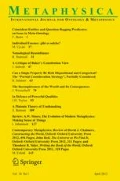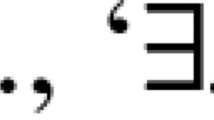Abstract
The theory of the ontological constitution of material objects based on bare particulars has recently experienced a revival, especially thanks to the work of J.P. Moreland. Moreland and other authors belonging to this ‘new wave’, however, have focused primarily on the issue whether or not the notion of a ‘bare’ particular is internally consistent. Not much has been said, instead, about the relation holding between bare particulars and the properties they are supposed to unify into concrete particulars. This paper aims to fill this gap and, making reference primarily to Moreland’s version of the theory, highlight some aspects and consequences of it that have not received due attention so far. It is argued that, given a number of seemingly plausible metaphysical assumptions, supporters of bare particulars are led to either endorse supersubstantivalism—the view that material objects are identical with regions of space–time—or abandon their theory altogether. Whatever one makes of the proposed conclusion, a dialectical structure emerges that puts precise constraints on bare particular ontologies and, therefore, will have to be taken into account in future discussion of these and related topics.
Similar content being viewed by others
Notes
Normally intended as universals, though they need not be.
Mertz uses an analogy with the fact that both Square and Circle are contrary to Triangle, so that two incompatible entities are both related, via the same relation, to a third one.
Moreland and Pickavance suggest a distinction between these two features that seems ungrounded. Here, particularity and unrepeatability will be regarded as one and the same thing.
Notice that here, as in what follows, the assumptions are by no means presented as obviously compelling or inevitable. The relevant claims have to be understood as conditional claims. In this case, the idea is, for instance, that if one thinks that non-moderate haecceitism is implausible, then one will have to take Campbell’s objection seriously and formulate the BP theory accordingly.
Detailed arguments in support of this claim are given in Lowe (2005).
Lowe makes it clear that ‘explanation’ does not have here an epistemic connotation but a metaphysical one. For the necessity of asymmetry for explanation relations, he refers to Ruben (1990; Ch. 7).
For instance, resemblance nominalism (see, e.g. Rodriguez-Pereyra (2002)), while preserving the idea that concrete particulars are not reducible to their qualitative aspects and are, instead, ontologically prior to them, does not assume that the fundamental ‘material nuclei’ of objects constitute an autonomous ontological category. In relation to this, it is worth mentioning that, in a recent discussion of BPs, Davis and Brown (2008) have proposed an ontology of ‘simple aspected particulars’ connected to their properties essentially and individuated by haecceities.
Another way for the BP theorist to obtain the same result is to claim that property-instances are numerically unique and primitively individuated tropes that, as such, can exist independently of BPs. However, the large majority of supporters of BPs, including Moreland, identify the fundamental (if not unique, as in Moreland’s case) role of BPs with that of individuators of concrete particulars and their properties. Clearly, introducing tropes makes this function unnecessary, so directly leading one to question the BP theory itself. More generally, it looks as though the introduction of BPs in one’s ontology should not dictate how one should conceive of properties.
Of course, other than the constraints preventing contradictory properties from being exemplified by concrete particulars (see above). Pointing at these constraints does not help the BP theorist here.
Notice that this does not conflict with the existence of constraints on how exactly entities of one category get connected to entities of the other. For detailed discussion of Hume’s Dictum, see Wilson (2010).
Or at any rate, minimal regions of space, conceived in harmony with physics (see Braddon-Mitchell and Miller (2006)). We will talk of points and regions more or less interchangeably in what follows, as nothing in the arguments being presented hinges on this.
I say ‘more or less’ in the main text because, in spite of the obvious significance of Relativity Theory, the debate between three-dimensionalism (i.e. presentism) and four-dimensionalism is still open, and in fact appears to be such that it cannot be settled on the basis of current physics alone.
In this context, the BP theorist will conceive of BPs either as extended four-dimensional simples, or as point-like constituents of instantaneous object-stages, connected to other stages via relations to be further specified. We do not need to pick one particular option here.
The well-known hole argument (see Norton (2008)) is also taken by some to show that General Relativity lends support to (super)substantivalism.
Ways out of this have been identified: supersubstantivalists can either explain away the relevant differences as appearances; or give up geometrical essentialism—the doctrine that points of space–time have their properties essentially; or abandon compositional essentialism for space–time regions—the view that the latter cannot contain different points in different possible worlds. There seems to be no obvious way to proceed here, but see Skow (2005; paragraphs 3.7–3.8) for the suggestion that giving up geometrical essentialism might be considered the best option because on the basis of General Relativity.
Perhaps, they will have to allow for single BPs—or parts of them, in case they are conceived of as four-dimensional simples—to determine the identity of more than one concrete particular or object-stage; or, maybe, explain away the relevant possibility (in the quantum case, for instance, by shifting to talk about modes of single field-points rather than particles).
References
Adams, R.M., (1979): Primitive Thisness and Primitive Identity, in Journal of Philosophy, 76, 5–25.
Allaire, E.B., (1963): Bare Particulars, in Philosophical Studies, 14, 1–7.
Armstrong, D.M., (2000): Universals as Attributes, in Kim, J. and Sosa, E. (eds.): Metaphysics: An Anthology, Blackwell, Oxford, 198–208.
Braddon-Mitchell, D. and Miller, K., (2006): The Physics of Extended Simples, in Analysis, 66, 222–226.
Campbell, K., (1990): Abstract Particulars, Blackwell, Oxford.
Catterson, T.T., (2008): Reducing Reductionism: On a Putative Proof for Extreme Haecceitism, in Philosophical Studies, 140, 149–159.
Chisholm, R., (1967): Identity through Possible Worlds: Some Questions, in Noûs, 1, 1–8.
Davis, R.B., (2003): Partially Clad Bare Particulars Exposed, in Australasian Journal of Philosophy, 81, 534–548.
Davis, R.B., and Brown, R.S., (2008): A Puzzle for Particulars?, in Axiomathes, 18, 49–65.
Fine, K., (1994): Essence and Modality, in Tomberlin, J. (ed.): Philosophical Perspectives, Ridgeview Publishing, Atascadero, 1–16.
LaBossiere, M., (1994): Substances and Substrata, in Australasian Journal of Philosophy, 72, 360–370.
Lowe, E. J., (2003): Individuation, in Loux, M.J. and Zimmerman, D.W. (eds.): The Oxford Handbook of Metaphysics, Oxford University Press, Oxford, 75–95.
Lowe, E.J., (2005): Ontological Dependence, in Zalta, E.N. (ed.): The Stanford Encyclopedia of Philosophy (Summer 2005 Edition), URL = http://plato.stanford.edu/archives/sum2005/entries/dependence-ontological/>.
Mertz, D.W., (2001): Individuation and Instance Ontology, in Australasian Journal of Philosophy, 79, 45–61.
Moreland, J.P., (1998): Theories of Individuation: A Reconsideration of Bare Particulars, in Pacific Philosophical Quarterly, 79, 251–263.
Moreland, J.P., (2003a): Hud Hudson’s 4D-Partism and Human Persons, in Philosophia Christi, 5, 545–554.
Moreland, J.P., (2003b): Review of A Materialistic Metaphysics of the Human Person by Hud Hudson, in Religious Studies, 39, 235–246.
Moreland, J.P. and Pickavance, T., (2003): Bare Particulars and Individuation. Reply to Mertz, in Australasian Journal of Philosophy, 81, 1–13.
Norton, J.D., (2008): The Hole Argument, in Zalta, E.N. (ed.): The Stanford Encyclopedia of Philosophy (Winter 2008 Edition), URL = <http://plato.stanford.edu/archives/win2008/entries/spacetime-holearg/>.
Pickavance, T., (2009): In Defence of ‘Partially Clad’ Bare Particulars, in Australasian Journal of Philosophy, 87, 155–158.
Preston, A., (2005): Quality Instances and the Structure of the Concrete Particular, in Axiomathes, 15, 267–292.
Rodriguez-Pereyra, G., (2002): Resemblance Nominalism: A Solution to the Problem of Universals, Clarendon Press, Oxford.
Ruben, D.-H., (1990): Explaining Explanation, Routledge, London.
Salmon, N., (1996): Trans-World Identification and Stipulation, in Philosophical Studies, 84, 203–223.
Schaffer, J., (2009): Spacetime the One Substance, in Philosophical Studies, 145, 131–148.
Sellars, W., (1952): Particulars, in Philosophy and Phenomenological Research, 13, 184–199.
Sider, T., (2001): Four-Dimensionalism: An Ontology of Persistence and Time, Oxford University Press, Oxford.
Sider, T., (2006): Bare Particulars, in Philosophical Perspectives, 20, 387–397.
Skow, B., (2005): Once Upon a Spacetime, PhD thesis, New York University.
Wilson, J., (2010): What is Hume’s Dictum, and Why Believe It?, in Philosophy and Phenomenological Research, 80, 595–637.
Author information
Authors and Affiliations
Corresponding author
About this article
Cite this article
Morganti, M. Substrata and Properties: From Bare Particulars to Supersubstantivalism?. Int Ontology Metaphysics 12, 183–195 (2011). https://doi.org/10.1007/s12133-011-0085-3
Published:
Issue Date:
DOI: https://doi.org/10.1007/s12133-011-0085-3




